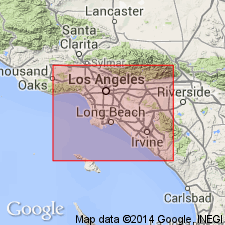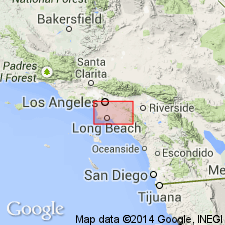
- Usage in publication:
-
- Holz member
- Modifications:
-
- Original reference
- Biostratigraphic dating
- Dominant lithology:
-
- Shale
- Siltstone
- Sandstone
- Conglomerate
- AAPG geologic province:
-
- Peninsular Ranges province
Summary:
Pg. 380. Holz member of Ladd formation. Briefly described in "Generalized section of formations in the Santa Ana Mountains, California." Is upper member (of 2) of Ladd formation. Consists of dark-bluish- to brownish-gray micaceous sandy shale or siltstone, with interbedded arkosic sandstones and nonpersistent coarse conglomerate lenses. Fossiliferous in upper half. Thickness about 1,500 feet. Overlies Baker member (new) of Ladd formation. Unconformably underlies Schulz member of Williams formation (both new). Age is Late Cretaceous based on molluscan fossils described in report.
Source: Publication; GNU records (USGS DDS-6; Menlo GNULEX); US geologic names lexicon (USGS Bull. 1200, p. 1790).

- Usage in publication:
-
- Holz shale member
- Modifications:
-
- Principal reference
- Biostratigraphic dating
- Dominant lithology:
-
- Shale
- Limestone
- Sandstone
- Conglomerate
- AAPG geologic province:
-
- Peninsular Ranges province
Summary:
Pg. 166, 168 (fig. 2), 171-173. Holz shale member of Ladd formation. (Also referred to as Holz member or Holz shale.) Consists predominantly of soft, poorly bedded, brownish gray, micaceous sandy shale with thin beds of concretionary limestone, thin beds of gritty sandstone, and lenses of coarse conglomeratic sandstone and massive conglomerates. Thickness 1,000 to 1,500 feet. Overlies Baker Canyon member of Ladd formation; disconformably underlies Schulz member of Williams formation. Age is Late Cretaceous based on molluscan fauna listed and described in report. Type locality designated.
Type locality: Holz Ranch on north side of Silverado Canyon, just west of mouth of Ladd Canyon, Santa Ana Mountains, Orange Co., southern CA. Holz is most persistent and thickest member of Cretaceous sequence in Santa Ana Mountains; extends in virtually unbroken exposure from Santa Ana Canyon south to near Trabuco Canyon, about 15 mi.
Source: GNU records (USGS DDS-6; Menlo GNULEX); US geologic names lexicon (USGS Bull. 1200, p. 1790).

- Usage in publication:
-
- Holz shale member*
- Modifications:
-
- Adopted
- AAPG geologic province:
-
- Peninsular Ranges province
Summary:
Holz shale member of Ladd formation shown on stratigraphic section of northwestern Santa Ana Mountains as unconformably underlying Silverado formation (new). Age given as Late Cretaceous.
Source: GNU records (USGS DDS-6; Menlo GNULEX).
For more information, please contact Nancy Stamm, Geologic Names Committee Secretary.
Asterisk (*) indicates published by U.S. Geological Survey authors.
"No current usage" (†) implies that a name has been abandoned or has fallen into disuse. Former usage and, if known, replacement name given in parentheses ( ).
Slash (/) indicates name conflicts with nomenclatural guidelines (CSN, 1933; ACSN, 1961, 1970; NACSN, 1983, 2005, 2021). May be explained within brackets ([ ]).

